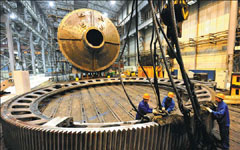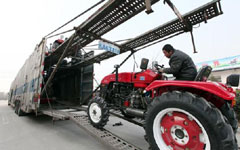Two defining features of today's new global economy are the rise of Asia and the power of interconnections.
Less than fifty years ago, the emerging markets and developing countries accounted for less than a quarter of global GDP. Today, it is half and rising rapidly, very likely to two-thirds of global GDP within the next decade.
Asia, and China in particular, are key drivers of this astounding growth. And with their rise comes the remarkable
 |
|
 |
Just as this new global economy will continue to expand, it will also continue to draw closer together.
Think of trade: not only has the global volume grown exponentially, but so too have the global supply chains, with more than half of total manufactured imports now "intermediate", that is made from components from different countries. As the manufacturing hub of the Asian supply chain, China is at the vanguard of this trade integration.
The same is true of financial flows. In the two decades before the crisis in 2008, global bank lending, as a share of world GDP, rose by 250 percent. As more countries, such as China, open up to the global economy, these financial flows will increase further, and will take different routes and pipes and channels. For instance, Internet banking is around the corner.
The power of interconnections is perhaps most visible in communications. Some call it the "hyper-connected world", and once again, it is driven in large part by Asia and other emerging economies. Today in China, for example, virtually everyone has a mobile device, and thus a potential connection to the Internet, and a potential connection to the world.
So a new and exciting future is being forged even as we speak - or perhaps I should say even as we tweet! It is a world of limitless opportunities and amazing potential. We are used to labels that say, "Made in China". But this world is truly "made for China".
Then how can China make the most of this new world? By thinking services, thinking inclusion, thinking green.
First, think services. China's current growth model has made it the manufacturing hub for the world. But this can only take it so far. China must now take the next step, moving further up the value-added chain with a services sector driven by productivity and innovation. For this, a top-notch education system and a modern, globally integrated financial system will be key.
Certainly, China has made significant strides by investing in education and knowledge-based activities. The resources allocated to research and development have been raised to 2 percent of GDP - equal that of many advanced economies. China now ranks first globally in terms of assessment in reading, mathematics and science.
Great progress; but to continue to nurture innovation, these investments must be sustained and expanded. They also need to be "internationalized" to benefit from greater collaboration and knowledge exchange across countries.
